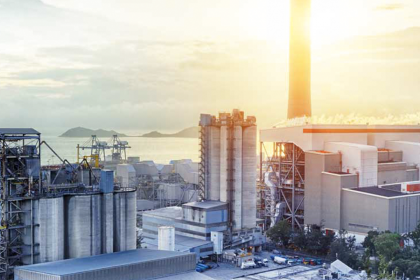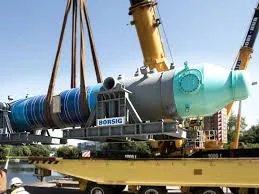
Manufacturing industries use efficient steam boilers for operational purposes that require heat. Although steam boilers generate sufficient steam and heat for process plants, it also wastes a significant amount of heat that could be used for other purposes. Therefore, industries have started investing in waste heat recovery boilers to use as much wasted heat as possible and promote sustainability. Using the waste heat recovery for preheating combustion air is commonly used in medium- to high-temperature furnaces. Using preheated air for the burners reduces the amount of fuel required to meet the process heat requirements.
As the name suggests, using a waste heat recovery boiler to recover part of the exhaust gas heat is an option for plants that require a source of steam or hot water. The waste heat recovery boiler is similar to steam boilers with the difference of heating through the exhaust gas stream from a process furnace rather than its burner. Waste heat recovery boilers are the ideal solution for plants that need additional steam capacity. However, the boiler generates steam only when the process is running.
Heat Losses in Process Industry:
Depending on the process type, waste heat is released at any temperature from cooling water to high-temperature waste gasses from an industrial furnace. Usually, high temperature leads to a high quality that is more cost-effective for heat recovery. In case of any waste heat recovery boiler, there must be some use for the recovered heat. With heat recovery of high temperature, a cascade system of waste heat recovery is practiced to ensure the optimal amount of heat, recovered at the highest potential.
In any waste heat recovery, it is essential to know the amount of heat recoverable. In a heat treatment furnace, the exhaust gasses exit the furnace at 900°C at the rate of 2100 m3/hour.
The total heat recoverable at 180oC final exhaust is calculated as,
Q = V × ρ × Cp × ∆T
Where,
Q = heat content in kCal
V = flowrate of the substance in m3 /hr
ρ = density of the flue gas in kg/m3
Cp = specific heat of the substance in kCal/kg °C
∆T = temperature difference in °C
Waste heat recovery boiler
How to Increase Efficiency in Waste Heat Recovery Boilers?
- Minimize exhaust gas temperatures:
Excessive exhaust gas temperatures are caused by poor heat transfer in the furnace. If the combustion gasses fail to transfer the maximum possible heat to the furnace and its contents, it exits the furnace at higher temperatures than necessary. Optimizing heat transfer within the furnace requires different methods, depending on the situation.
Overloading a furnace can also cause excessive stack temperatures. For the proper heat transfer rate, combustion gasses should remain in the heating chamber for the appropriate amount of time. Usually, an overloaded furnace runs colder than optimal unless the temperature is artificially high. It leads to the burners operating at higher than normal firing rates, increasing combustion gas volumes. The higher gas flow rates and shorter time in the furnace result in poor heat transfer, leading to a higher temperature for the flue gasses. Increased volumes of high-temperature flue gasses result in significantly increased heat losses. Due to this, high production goals are accomplished, but at the cost of excessive fuel consumption.
- Minimize exhaust gas volumes:
The two ways to lower waste gas flows are preventing overloading and optimizing heat transfer along with others. The ideal way is to control fuel-air ratios. Operating the furnace at the optimal fuel-air ratio for the process controls fuel consumption. It can be performed with the existing control equipment with little maintenance attention. A reduction in the exhaust volumes is the indirect result of efficiencies applied elsewhere.
- Use of oxygen-enriched combustion air:
Ambient air consists of approximately 21% oxygen with nitrogen and other inert gasses as balance. The total volume of exhaust gasses is reduced by increasing the oxygen content of combustion air by mixing in ambient air or by using 100% oxygen. Reducing exhaust gasses leads to substantial fuel savings. The amount of saved energy depends on the percentage of oxygen in combustion air and the flue gas temperature. High values of oxygen and flue gas temperature offer higher fuel savings.
Benefits of Waste Heat Recovery Boiler:
The benefits of waste heat recovery boilers are broadly classified into two categories:
Direct Benefits:
The recovery of waste heat directly impacts the efficiency of the operation process. It is proved by the reduction in utility consumption, utility costs, and process costs.
Indirect Benefits:
Pollution reduction: Various combustible wastes like carbon monoxide gas, carbon black off-gasses, oil sludge, acrylonitrile, plastic chemicals, etc., are burned in the incinerators, it release into the atmosphere, and serve the dual purpose of recovering heat and reducing pollution levels.
Reduction in equipment sizes: Waste heat recovery boiler reduces the fuel consumption, leading to a reduction in the produced flue gas. It leads to a reduction in the sizes of all flue gas handling equipment like fans, stacks, ducts, burners, etc.
Reduction in auxiliary energy consumption: Reduction in equipment sizes results in additional benefits with a reduction in auxiliary energy consumption like electricity for fans, pumps, etc.


